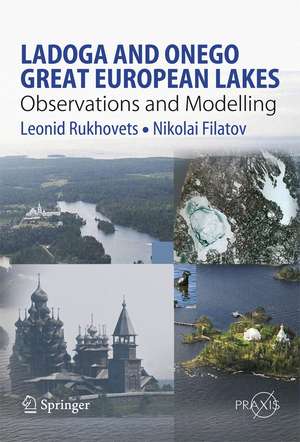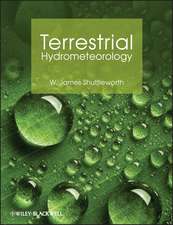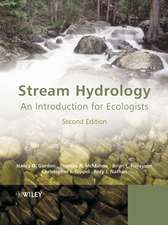Ladoga and Onego - Great European Lakes: Observations and Modeling: Springer Praxis Books
Autor Leonid Rukhovets, Nikolai Filatoven Limba Engleză Paperback – 14 mar 2012
The anthropogenic impact on the Lake Onego ecosystem is mostly determined by the sewage waters of the Petrozavodsk and Kondopoga industrial centres, while the river inflow makes the most impact on Lake Ladoga. Although the anthropogenic stress on the water ecosystems of the Great European Lakes has decreased over the last 15 years, there has been some simultaneous evidence of global warming. There is not enough current data to identify the climate-induced changes in lake ecosystems, but there is proof that the main cause of lacustrine ecosystem changes is determined by anthropogenic factors.
| Toate formatele și edițiile | Preț | Express |
|---|---|---|
| Paperback (1) | 945.92 lei 6-8 săpt. | |
| Springer Berlin, Heidelberg – 14 mar 2012 | 945.92 lei 6-8 săpt. | |
| Hardback (1) | 956.03 lei 6-8 săpt. | |
| Springer Berlin, Heidelberg – 15 oct 2009 | 956.03 lei 6-8 săpt. |
Din seria Springer Praxis Books
-
 Preț: 294.46 lei
Preț: 294.46 lei -
 Preț: 223.45 lei
Preț: 223.45 lei -
 Preț: 193.12 lei
Preț: 193.12 lei -
 Preț: 167.85 lei
Preț: 167.85 lei -
 Preț: 288.98 lei
Preț: 288.98 lei -
 Preț: 323.74 lei
Preț: 323.74 lei -
 Preț: 401.38 lei
Preț: 401.38 lei -
 Preț: 264.12 lei
Preț: 264.12 lei - 8%
 Preț: 513.00 lei
Preț: 513.00 lei -
 Preț: 190.01 lei
Preț: 190.01 lei -
 Preț: 218.16 lei
Preț: 218.16 lei -
 Preț: 312.06 lei
Preț: 312.06 lei - 17%
 Preț: 414.05 lei
Preț: 414.05 lei -
 Preț: 216.41 lei
Preț: 216.41 lei -
 Preț: 262.27 lei
Preț: 262.27 lei -
 Preț: 264.35 lei
Preț: 264.35 lei -
 Preț: 167.63 lei
Preț: 167.63 lei -
 Preț: 284.81 lei
Preț: 284.81 lei -
 Preț: 259.08 lei
Preț: 259.08 lei -
 Preț: 305.47 lei
Preț: 305.47 lei -
 Preț: 244.14 lei
Preț: 244.14 lei -
 Preț: 227.85 lei
Preț: 227.85 lei -
 Preț: 285.25 lei
Preț: 285.25 lei -
 Preț: 295.56 lei
Preț: 295.56 lei -
 Preț: 357.17 lei
Preț: 357.17 lei -
 Preț: 275.79 lei
Preț: 275.79 lei -
 Preț: 257.08 lei
Preț: 257.08 lei -
 Preț: 349.71 lei
Preț: 349.71 lei -
 Preț: 272.45 lei
Preț: 272.45 lei -
 Preț: 270.27 lei
Preț: 270.27 lei - 8%
 Preț: 456.51 lei
Preț: 456.51 lei -
 Preț: 352.34 lei
Preț: 352.34 lei - 8%
 Preț: 394.80 lei
Preț: 394.80 lei -
 Preț: 320.65 lei
Preț: 320.65 lei -
 Preț: 325.29 lei
Preț: 325.29 lei -
 Preț: 253.11 lei
Preț: 253.11 lei -
 Preț: 192.86 lei
Preț: 192.86 lei -
 Preț: 313.40 lei
Preț: 313.40 lei -
 Preț: 150.51 lei
Preț: 150.51 lei -
 Preț: 233.34 lei
Preț: 233.34 lei -
 Preț: 286.78 lei
Preț: 286.78 lei -
 Preț: 212.01 lei
Preț: 212.01 lei -
 Preț: 366.83 lei
Preț: 366.83 lei -
 Preț: 299.99 lei
Preț: 299.99 lei -
 Preț: 232.27 lei
Preț: 232.27 lei -
 Preț: 284.58 lei
Preț: 284.58 lei -
 Preț: 212.45 lei
Preț: 212.45 lei -
 Preț: 159.81 lei
Preț: 159.81 lei -
 Preț: 349.48 lei
Preț: 349.48 lei - 20%
 Preț: 2061.64 lei
Preț: 2061.64 lei
Preț: 945.92 lei
Preț vechi: 1153.57 lei
-18% Nou
Puncte Express: 1419
Preț estimativ în valută:
180.99€ • 188.99$ • 149.46£
180.99€ • 188.99$ • 149.46£
Carte tipărită la comandă
Livrare economică 15-29 aprilie
Preluare comenzi: 021 569.72.76
Specificații
ISBN-13: 9783642260902
ISBN-10: 364226090X
Pagini: 324
Ilustrații: XVI, 308 p. 136 illus., 4 illus. in color.
Dimensiuni: 170 x 242 x 17 mm
Greutate: 0.46 kg
Ediția:2010
Editura: Springer Berlin, Heidelberg
Colecția Springer
Seriile Springer Praxis Books, Environmental Sciences
Locul publicării:Berlin, Heidelberg, Germany
ISBN-10: 364226090X
Pagini: 324
Ilustrații: XVI, 308 p. 136 illus., 4 illus. in color.
Dimensiuni: 170 x 242 x 17 mm
Greutate: 0.46 kg
Ediția:2010
Editura: Springer Berlin, Heidelberg
Colecția Springer
Seriile Springer Praxis Books, Environmental Sciences
Locul publicării:Berlin, Heidelberg, Germany
Public țintă
ResearchCuprins
The Great European Lakes: state of the art.- Hydrothermodynamics of large stratified lakes.- Climatic circulation and the thermal regime of the lakes.- Estimation of the lakes’ thermohydrodynamic changes under the impact of regional climate change.- Three-dimensional ecosystem model of a large stratified lake.- Ecosystem models of Lakes Ladoga and Onego.- Estimating potential changes in Lakes Ladoga and Onego under human and climatic impact.- Lake Ladoga and Lake Onego models of fish communities.- Natural resources of Lakes Ladoga and Onego and sustainable development of the region.
Notă biografică
Leond Aizikovich Rukhovets, professor, Doctor of Sciences, he started to work in Leningradean Branch of Steklov Mathematical Institute, USSR Academy of Sciences in 1959. In this Branch he worked during the period 1959-1965. The next periods 1965-1975,1975-1985 he was the scientific researcher in Lenigradean Branch of Central Institute of Mathematics and Economics, USSR Academy of Scieces and Leningradean Institute of Social and Economical Problems, USSR Academy of Sciences correspondingly. During period 1986-1990 he worked in Limnological Institute, USSR Academy of Sciences at Leningrad. He received his doctor's degree in computational mathematics in 1970 from Leningradean Branch of Steklov Mathematical Institute of USSR Academy of Sciences. His dissertation was devoted to study the finite element method (FEM) for solution boudary value problems for differential equations with partial derivatives. Later the interest of his investigations was focused upon the computational geophysicalhydrodynamics, models of large lakes circulation, ecosystem models and its implementation in conservation and managemtnt of water resources. In 1990 he was awarded a Doctor of Sciences degree in physics and mathematics. Leonid Rukhovets is the author more than 130 scientific articles and eight books. He took part in conferences and was visiting scientist in Oceanology Institute of Poland Academy of Sciences (Poland,1989), in Finland (1995, 1996, 1998, 2003,2006), USA(1999), Danmark (1999), Estonia (2006), Canada (2007). From 1998 to present Leonid Rukhovets is working in Institute for Economics and Mathematics at St.Petersburg, RAS as Director of Instirute and a head of the laboratory of mathematical modelling. He is a professor of State Marine Technical University.
Nikolai Nikolaevich Filatov , professor, Ph.D., He start work in limnilogical institute, Academy of Sc. and received his doctorate in geography in 1975 from the State University in Leningrad , where he conducted investigations of currents in Large Lakes. He are working in the Institute for Lakes Research of the Russian (then USSR) Academy of Sciences from 1971-1988 y., where his research interests become focused upon limnological, hydrophisics , and remote sensing.. He was awarded a D.Sc. degree in 1991. He has authored more than 300 scientific articles and 10 books. Now he is working in Nortern Water Problems Instittute as Director of the institute and head of laboratory of Geographical. His research activities continue to be directed toward the remote sensing, limnology and phisics of inland waters. He was visiting scientist in Canada (1979,1990), Austria, in International institute for Applied system analysis(1977), Finland (1983,1990,1993,1995-2002), Sweden (1992,1996, 2001, 2004).He is proffesor of State Pedagogical university (Petrozavodsk), President of Karelian Geographical society.
Nikolai Nikolaevich Filatov , professor, Ph.D., He start work in limnilogical institute, Academy of Sc. and received his doctorate in geography in 1975 from the State University in Leningrad , where he conducted investigations of currents in Large Lakes. He are working in the Institute for Lakes Research of the Russian (then USSR) Academy of Sciences from 1971-1988 y., where his research interests become focused upon limnological, hydrophisics , and remote sensing.. He was awarded a D.Sc. degree in 1991. He has authored more than 300 scientific articles and 10 books. Now he is working in Nortern Water Problems Instittute as Director of the institute and head of laboratory of Geographical. His research activities continue to be directed toward the remote sensing, limnology and phisics of inland waters. He was visiting scientist in Canada (1979,1990), Austria, in International institute for Applied system analysis(1977), Finland (1983,1990,1993,1995-2002), Sweden (1992,1996, 2001, 2004).He is proffesor of State Pedagogical university (Petrozavodsk), President of Karelian Geographical society.
Textul de pe ultima copertă
This book studies the contemporary problems of the Great European Lakes – Ladoga and Onego - on both a regional and a global scale, placing special emphasis on interactions between the limnological and socio-economic environments. Field observations and numerical modeling are used to investigate the responsiveness of both environments to respective impacts, as well as to regional and global climate change. The authors, experts in a wide spectrum of natural and human sciences, use a quantitative approach to assess current and future changes to the interactions between the socio-economic dynamics and limnology of the largest European Lakes compared with the great North American Lakes.
Caracteristici
A comprehensive and adequate portrait of the Great European Lakes trophic state, and a quantitative assessment of vulnerability of the Great European Lakes bio-resources to future anthropogenic and climate change forcing






